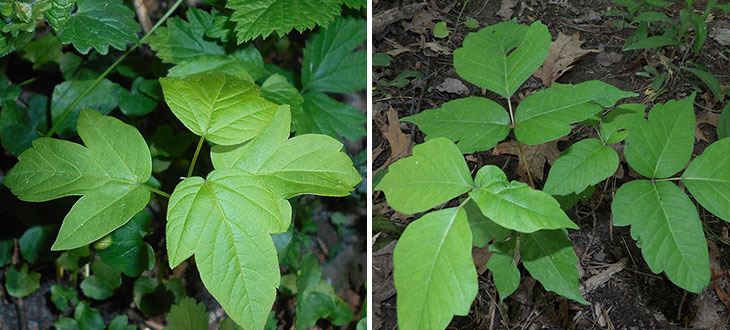Poison Ivy Vs. Box Elder Comparison
Do you want to learn how to differentiate poison ivy from box elder? Here is a comparison between these two plants and the key things you need to know to be able to identify these two plants correctly.
Whether you are a forager or just someone who likes to adventure into the wild and use what nature gives you, knowing how to make a distinction between various plant species is a priceless skill.
While some species of plants are a blessing from nature, others can be a nuisance and even deadly if eaten. Thus, it is really vital to know what you are doing.
Today we will talk about two plants that, although they are not botanically related, are almost identical in appearance when young and are very difficult to distinguish from one another. More precisely, we will make a comparison between box elder and poison ivy and underline the similarities and differences between these two.
Introduction
Box elder (Acer negundo), also known as boxelder, boxelder maple, or ash-leaved maple, is a species of a fast-growing and relatively short-lived maple tree. It belongs to the botanical family Sapindaceae, genus Acer.
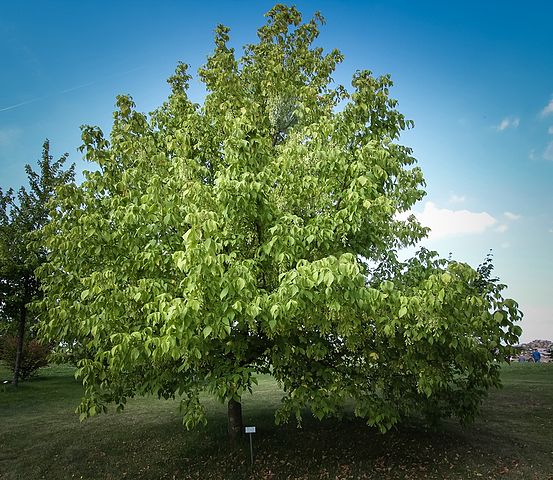
These trees are native to North America but have been naturalized through cultivation in numerous regions of the world.
Poison ivy is the name generally used for three species of plants in the genus Toxicodendron. However, the species that is the most common and the one we are going to talk about in this article is Toxicodendron radicans.
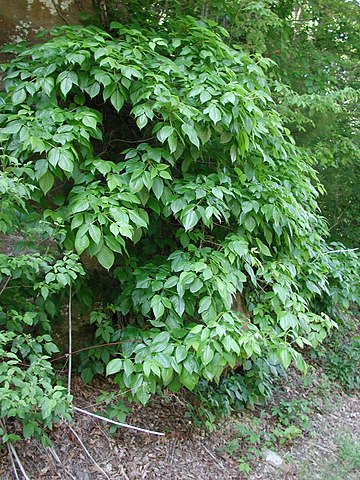
This species of poison ivy is native to North America and parts of Asia.
Growth Habit
Both poison ivy and box elder prefer similar habitats and can even be found growing next to each other.
The most obvious difference between these plants is their growth habit. Box elder grows as a medium-to-large tree, reaching heights of up to 35–80 feet (10–25 meters), while poison ivy typically grows as a woody climbing or trailing vine, or as a small shrub that does not usually exceed 4 feet (1.2 meters) in height.
Box elder has fast growth and can quickly colonize new areas. That is why it is considered an invasive plant in different regions of the world.
Poison ivy can grow both in sun and shade. It is frequently seen extending on various trees that provide natural support for it, or on various constructions or fences in populated areas. It can also be found on the ground when it does not have support nearby or develops as a small shrub.
At maturity, these two plants are quite easy to distinguish. However, when the plants are young, they look very similar and can easily be mistaken for each other.
Leaves & Stems
When box elder is young, its leaves are almost identical to the ones of poison ivy. Only some small details can help you distinguish them.
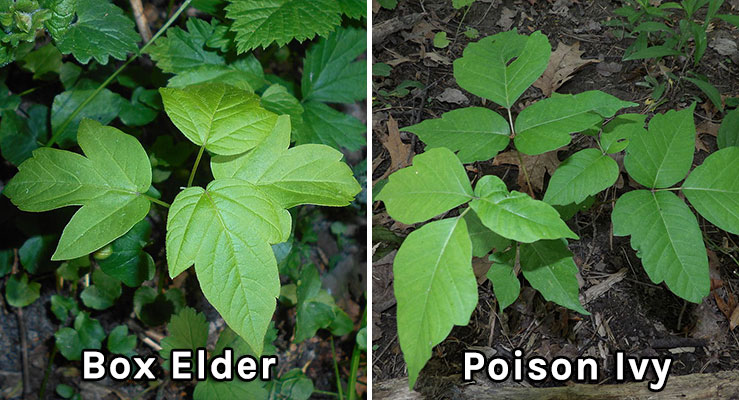
One key difference between these two plants is the disposal of the leaves on the stems. The leaves of box elder are arranged oppositely on stems, while the ones of poison ivy are arranged alternately.
In other words, the leaves of box elder grow oppositely, in pairs, at each node, while every node of poison ivy develops a single leaf.
The leaves of box elder and poison ivy are similar in shape and color. Both plants have compound leaves that consist of three or more individual leaflets with toothed margins (sometimes rounded in poison ivy), pointed tips, and smooth surfaces. However, what may help you discern between these two plants, is the number of leaflets per leaf.
The leaves of poison ivy are composed almost always of 3 leaflets, while the ones of box elder can have from 3 to 7 leaflets. Keep in mind though that 3-leaflet leaves are very common in young box elder plants. Thus, this characteristic alone is not enough to clearly make a distinction between these two plants.
The stems of box elder can slightly vary in color, just like the ones of poison ivy, depending on the plant’s age and other factors. Even so, their color may give us an additional hint about the plant we are trying to identify.
For instance, the stems of young box elder plants often have a silvery-green to almost bluish shade with a waxy look, while the ones of poison ivy are usually green, brown, or reddish and do not have that waxy aspect.
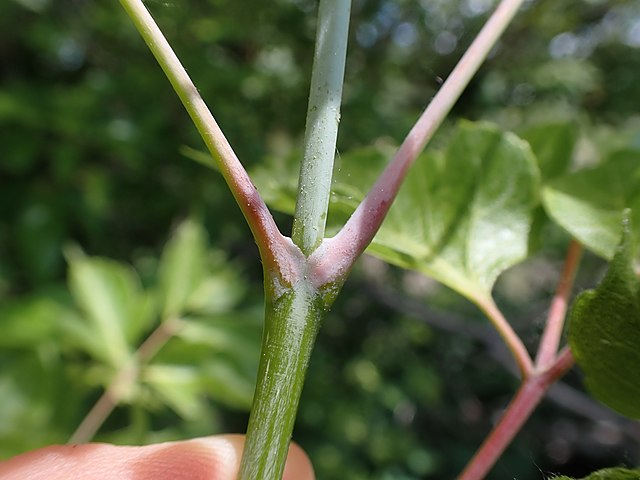
Something else to consider is that the leaves and stems of a young poison ivy plant may have a reddish pigment, while the ones of a box elder sapling are generally light green.
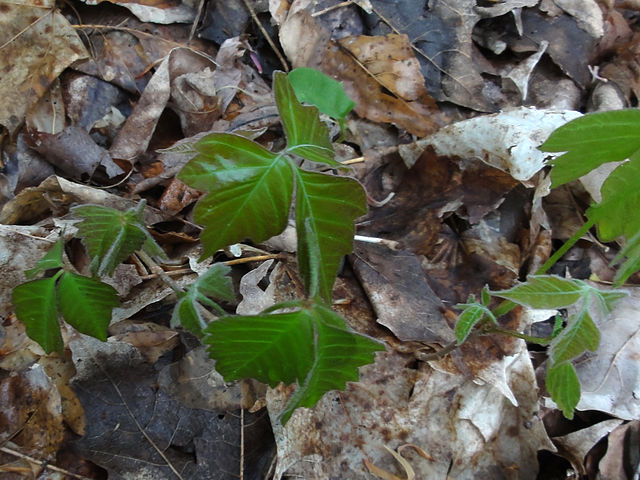
Flowers & Fruits
By the time the poison ivy and box elder plants produce flowers and fruits, they are already mature enough and should be easily distinguishable.
Poison ivy produces clusters of small, greenish, or yellowish-white flowers during spring.
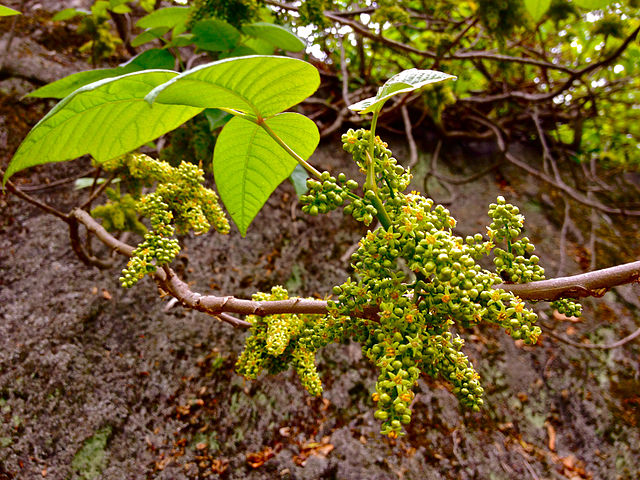
The box elder is a dioecious species of tree. This means that each tree is either male or female and the male and female flowers are on separate trees. The female flowers have pistils and the male flowers have stamens. Both types grow in hanging clusters and appear during spring.
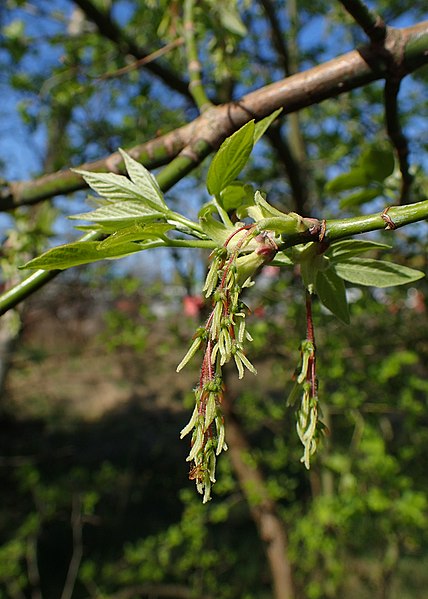
Poison ivy produces clusters of tiny berry-like fruits (botanically known as “drupes”), while box elder produces dry fruits (called “samaras”) that grow in drooping clusters.
The fruits of poison ivy are toxic to humans and should never be consumed.
Toxicity
Poison ivy
Poison ivy is a highly allergenic plant. Its sap contains an oily compound with powerful allergenic properties called “urushiol.” Because of it, poison ivy can trigger contact dermatitis in many people when touching the plant. In extreme cases, it can even lead to potentially fatal allergic reactions.
This compound can remain active for several years even in dead plants. Thus, handling dead poison ivy leaves or vines can likewise cause allergic reactions.
Urushiol is also very dangerous if the plants are burned because it will disperse in the air through smoke and can severely affect someone’s lungs if inhaled.
Box elder
The sap, inner bark, young leaves, and seeds of box elders are edible and used in making syrup, or consumed in various ways.
The box elder seeds, and possibly other parts of this plant, are known to be toxic to horses. Its pollen can also cause allergies in some individuals.
Conclusion
Box elder and poison ivy are two very similar-looking plants when the plants are young, and can be easily confused. However, as presented in this article, there are several details that can help you distinguish them even in the sapling stage. At maturity, they can easily be differentiated due to their different growth patterns.
We hope that this poison ivy vs. box elder comparison helped you understand the similarities and differences between these two plants.

